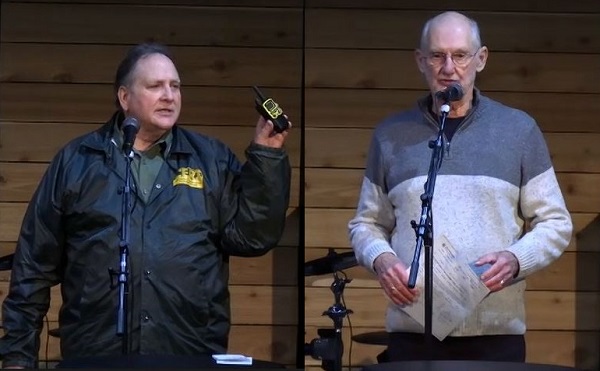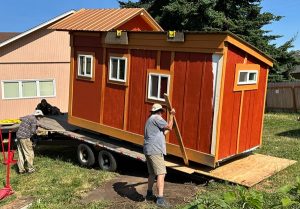Northeast Neighbors use human resource theory to build damage assessment teams
7 min read
Northeast Neighbors Andy Davis and Bill Haynes talked about their neighborhood damage assessment teams and the theory behind retaining volunteers. At the March 5 general meeting:
Andy Davis (Northeast Neighbors, CERT): So after a major disaster—whether it be the ice storm that we just went through or the 9.0 Cascadia (earthquake) that we’ve all been talking about and seeing so many reports—emergency responders, the 911 calls, the utility folks, they will not be able to come respond to you personally, to your needs, because they’re just going to be overwhelmed. So it’s good that you take care of yourself and your household on that.
I think it’s very important that the neighborhood be prepared and neighbors kind of look out for one another in their area and kind of work together.
So for your neighborhood: Get to know your neighbors. If they go on a vacation, watch their house. We used to do that years ago. But look out for your neighbors, take care of their pets and things like that, just keep an eye out.
[00:00:58] Neighbors that have particular needs: Know what the need is, so that if it’s so-and-so needs insulin and their power is out: Who has power? Maybe let’s put the insulin in that refrigerator for the neighbor that needs insulin.
[00:01:17] So get to know, in your neighborhood, who has special skills, whether it be medical skills or they have a chainsaw or things like that, to where you will help out one another.
[00:01:30] So it’s important that neighbors talk with one another, get to know each other, have neighbor night out and such like that. So it’s very important with that.
[00:01:41] Bill’s going to be talking about Lakeridge and they’ve really done some great work in taking care of their neighbors in that community. And he started off years ago with Map Your Neighborhood. How many have heard of that program, Map Your Neighborhood? OK, a few. We stole it from the state of Washington, and so it started up there, and we have used it. It’s still a very great program.
[00:02:10] You can be a CERT. CERT stands for—it’s not a breath mint. It stands for Community Emergency Response Team. I’m a volunteer for the Eugene Springfield CERT program, and so they came and at that time I was the chair of the steering committee and they said, ‘Come up with an emergency communications system for the city of Eugene.’
[00:02:35] So, well, what’s that going to look like? So we got a bunch of people together; it’s a network made up of volunteer ham radio operators. And the city is divided up in six districts, and we are living in the northeast district where we’re at, which is made up of Northeast Neighbors, Harlow Neighborhood, Cal Young Neighborhood and the Goodpasture Island Loop neighborhood.
[00:02:58] So we came up with the plans and we said, ‘Okay, that’s great, but who are the ham radio operators going to talk to?’ So we come up with another plan: ‘Well, let’s have the neighborhoods speak to the ham radio operators and tell us what is needed in their neighborhood.’ So we came up with a term: the damage assessment teams. We’re slowly getting more folks to volunteer to be damage assessment teams within their neighborhood.
[00:03:28] But I really want to impress upon you that we need volunteer ham radio operators and damage assessment teams within your neighborhoods so you can take care of one another.
[00:03:41] Bill’s going to be talking about Lakeridge and what they have done. It will expand more on that about the damage assessment teams and ham radio operators.
[00:03:54] Bill Haynes (Northeast Neighbors): My name is Bill Haynes. I’m a resident at Lakeridge which is roughly the corner of Ayers Road and where Delta Highway ends. Ayers Lake is right there and we’re built around that lake. I’ve been retired for 20 years, but prior to that, I was the vice president of HR for three different companies, most of them in the range of 1,000 (employees) or so. And the reason I mention all of that is because there’s some theoretical stuff that’s very helpful on taking advantage of community activities.
[00:04:31] And I just—very, very briefly—there are some things that have to do with people’s motivation. For the most part I know what I’m talking about in the business world and I’ve tried to transfer that to a volunteer world. And I want to share that with you because should you proceed, and I would really hope you do, there are some things that you can do that should help you be more successful in trying to put together a program following Andy’s guidelines.
[00:05:05] There’s a couple of people who were extremely influential, Frederick Herzberg and Abraham Maslow, and I suspect those names are familiar to some of you. Herzberg talked about motivation and what he came up with, and it’s been embellished since then, but getting back down to the basics of it, he had a list of five things: achievement; recognition; the work itself (this was in the business world); responsibility; advancement. Those are in priority order of how, in the research that he did, what was most influential for people.
[00:05:44] John Q: He also described Maslow’s hierarchy of needs.
[00:05:49] Bill Haynes (Northeast Neighbors): It’s usually defined in a pyramid, although he didn’t, but it has been embellished over the years into that. That also is a list of five: Our physiological needs like safety, food, shelter. The next one up is safety. We have to be in a safe place. We have to be, and that includes, in our modern society, is that includes financial safety even.
[00:06:18] Then the next two: belonging and esteem. Belonging is comfortable and connected to a group. And his research proved that it’s not a desire, it’s a need. The next one going up that list is esteem, which is respect from others and self-respect.
[00:06:38] And then it goes on to self-actualization. Now, how does that ever fit in with disaster preparation? Well, pretty closely. We’ve been moderately successful, I think, in putting together a number of different programs for a number of different people.
[00:06:53] And I want to talk specifically about the damage assessment teams. We got some training through Andy and his facilities. We got the FRS radios. And we communicate with Mike, who is the ham radio operator that we can reach, divided our community into four segments. We have teams one, two, three, and four. Each team has two people. So we have eight people that are involved in this. I’m the ninth.
[00:07:23] We also have a Neighborhood Watch committee. There’s four of us on that. That’s 13 people. We put those two together, those two groups, one group of 13 people now. And I posed: What are we going to do? How are we going to protect ourselves? How do we take care of ourselves on the smaller things than a great big earthquake? (That’ll protect us in the earthquake if it should come also.)
[00:07:49] So we’re meeting again now next month. We had 100% concurrence that yes, we want to do these two groups: the Damage Assessment Team and the Neighborhood Watch Committee. Should these things be organized?
[00:08:06] Well, you know, most of the time, if we’re going to put a group together, you find somebody who will act as president, chairperson; that’s fine, that works. But you’re relying on just one person. And how many times have you seen it where that one person is burned out? How long can they take it? And it can be personally destructive for someone to take on that much responsibility on a volunteer basis.
[00:08:35] So what we’ve tried to do is change the structures. You may have heard this term: ‘a leaderless group.’ It’s fun for a social group, maybe, but it didn’t work for what we were trying to do. We then tried using co-leaders—very successful.
[00:08:51] Another system—we’re doing this with what we call our events committee—and it has no permanent membership, it’s anybody, any resident who wants to come: just a facilitator for the meetings. I act as a facilitator to it and I explained to the committee in the beginning that I don’t want any more responsibility. I’ve got more than I can handle right now and I’m not that good. So I just will facilitate the group. I can take care of that but you guys are the ones who are going to decide who does what, who comes to the meetings, who doesn’t.
[00:09:27] It’s been really successful so far, and we’ve got probably the most complete event schedule that I think we’ve ever had. I’ve been there for almost eight years.
[00:09:37] And then this is my closing remark, really: The more you can be inclusive of people and the more you can meet the motivational standard that comes from Herzberg of recognition, and the more you can get into Maslow’s hierarchy of needs, particularly on the esteem portion and the belonging portion, those are the strongest ones. Those are the ones that are best accomplished by the kinds of leadership in the organizations that I’ve just described.
[00:10:17] Stay away from the president, the chairman concept. Keep it friendly, keep it personal, keep it inclusive, and you’ll be able to put groups together that will accomplish something.
[00:10:29] John Q: Tips for creating a long-lasting, fun, and successful neighborhood program from Northeast Neighbors Andy Davis and Bill Haynes. For more, get in touch with them at NENEugene.org, and then set up your own disaster assessment team in your own neighborhood.



